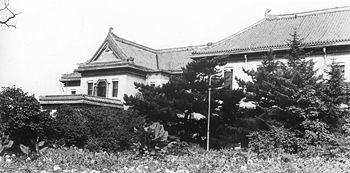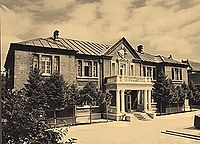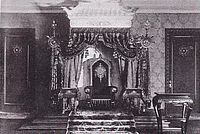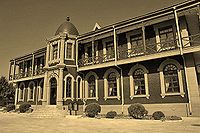- Museum of the Imperial Palace of the Manchu State
-
The Museum of the Imperial Palace of the Manchu State (Traditional Chinese: 偽滿皇宮博物院; Pinyin: Wěi Mǎn Huánggōng Bówùyuàn, literally The Illegitimate Manchukuo Imperial Palace Museum) is a museum in the northeastern corner of Changchun, Jilin province, northeast China. The Palace was the official residence created by the Imperial Japanese Army for China's last emperor Puyi to live in as part of his role as Emperor of the Japanese puppet state of Manchukuo. In the People's Republic of China the structures are generally referred to as the Puppet Emperor's Palace & Exhibition Hall.[1]
Contents
History
During the Japanese occupation of Manchuria from 1931 to 1945, the last emperor of the Qing dynasty, Puyi, was installed as the puppet leader of Manchukuo. Puyi was a resident of Wei Huang Gong from 1932 to 1945. After the fall of Manchukuo, the palace was damaged when Soviet troops looted Xinjing. Afterwards, the structures were preserved and opened as the Museum of Imperial Palace of "Manchu State" (偽滿皇宮博物院) in 1962. The exhibits were expanded with that of the former Jilin Museum in 1982, and renovated in 1984. The entire complex was renovated in 2004. The palace was the actual setting in Bernardo Bertolucci's 1987 biographical film of Puyi, The Last Emperor, depicting Puyi's reign as Emperor of Manchukuo.
Structures
The Manchurian Imperial Palace was designed as a miniature version of the Forbidden City in Beijing. It was divided into an inner court and outer court. The outer or front court was used for administrative purposes and the inner or rear court as the royal residence. The palace covers an area of 43,000 square meters.
The inner court includes the private living quarters for Puyi and his family. Its main structures include Jixi Building on the west courtyard and Tongde Hall on the east courtyard. The outer court contained buildings for affairs of state. Its main buildings include Qianmin Building, Huanyuan Building and Jiale Hall. The architecture of the buildings is in a wide range of styles: Chinese, Japanese, and European.
Within the complex were gardens, including a rockeries and fish pond, a swimming pool, air-raid shelter, a tennis court, a small golf course and a horse track.
Around the courtyards were nine two-storey blockhouses for the Manchukuo Imperial Guard, and the entire complex was surrounded by high concrete walls.
Jixi Building
The Jixi Building was the Russian-style private living quarters for the Emperor and his immediate family. It contained Puyi's bedroom, reading room, the family hall, Buddhist chapel and the separate quarters for Empress Wan Rong and the concubine Tan Yuling. Originally it was the office building of the Jilin-Heilongjiang Exclusive Transportation Bureau, and was built in the early 1900s.
Tongde Hall
The Tongde Hall is the largest and most impressive of the buildings in the palace, and has the most luxurious interior decoration. Originally the Jilin Salt Tax Collection Office, and therefore sometimes referred to as the "Salt Palace", Japanese engineers remodeled it from 1936 to 1938. However, Puyi refused to use the building, as he believed it to be bugged. The main hall was the setting for a dance party scene in the movie The Last Emperor, although it was never actually used for that purpose.[2]
The imperial concubine Li Yuqin was housed in the east part of the second floor. The building today contains the Manchukuo Throne, various pieces of furniture, some replicas of the crown jewels, flags, some dresses and uniforms, a copy of the Manchukuo declaration of independence, and other official items. High behind the throne is the national coat of arms, with a five point star, in different colors representing the five nationalities of Manchukuo: Manchu (red), Chinese (yellow), Mongol (blue), Japanese (white) and Koreans (black).
Qinmin Building
The Qinmin Building was Puyi's office building. In its southeast corner is a large room where Puyi received foreign ambassadors and consuls, and issued certificates of appointment and conferred medals to his government officials. The Qianmin Building housed the Manchukuo throne, which has now been moved to the Tongde Hall for the museum display.
Historical artifacts on display in the Qinmin Building include documents and photographs from Puyi's childhood to adulthood and wax figures of Puyi with one of his wives.[3] Additional exhibitions highlight war crime atrocities from World War II such as incidents related to the Unit 731.[4]
Zhixiu House
Zhixiu House was a detached structure built in the early 1930s. It was used as an informal dining hall by Emperor Puyi. A portion of Puyi's cash and jewels were kept in the two safes in the back apartment. After Puyi's second younger sister married Zheng Guangyuan, they lived here for a time. When the Tongde Building was completed, this structure was transformed into a school for the children of the palace employees.
Changchun House
Changchun House was another detached structure designed as a mirror image of Zhixue House to maintain symmetry in the palace layout. At first the fourth and the fifth younger sisters of Puyi lived here. In July 1937 it was the residence for Puyi's father, Zaifeng, when he visited briefly to congratulate Puyi on becoming Emperor. Afterwards, the residence was used by the imperial concubine Tan Yuling.
Huaiyuan Building
The Huaiyuan Building was built in the autumn of 1934 as an office for the Manchukou Imperial Household Agency, housing the Imperial Secretariat and various inner palace departments. It also contained the Fengxian Chapel where Puyi worshipped his ancestral portraits and memorial tablets.
Siheyuan
Siheyuan was another structure of the Inner Palace. Dating from the early 1900s, it was originally the mansion of Wei Zonglian, the head of Jilin-Heilongjiang Exclusive Transportation Bureau. After the creation of the palace, it was used as an office for the executive department, housing the offices of the Japanese vice-minister and related officials.
References
- ^ Travelchinaguide.com
- ^ Frommer's Guidebook.
- ^ China Travel. "China Travel." "Puppet Emperor's Palace Attraction." Retrieved on 2007-01-17.
- ^ China Travelz. "China Travelz." "Last Puppet Emperor's Palace & Exhibition Hall." Retrieved on 2007-01-17.
External links
Coordinates: 43°54′14″N 125°20′34″E / 43.90389°N 125.34278°E
Categories:- Museums in China
- Palaces in China
- Royal residences in China
- Buildings and structures in Changchun
- Manchukuo
Wikimedia Foundation. 2010.




